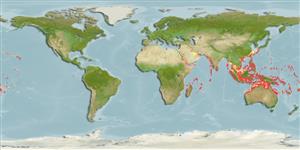Teleostei (teleosts) >
Lophiiformes (Anglerfishes) >
Antennariidae (Frogfishes)
Etymology: Antennarius: From Latin, antenna, antemna = sensory organ (Ref. 45335).
More on author: Shaw.
Environment: milieu / climate zone / depth range / distribution range
Ecology
Marine; reef-associated; depth range 0 - 75 m (Ref. 6773), usually ? - 16 m (Ref. 90102). Tropical; 32°N - 36°S, 29°E - 147°W (Ref. 57375)
Indo-Pacific: Red Sea and East Africa to the Hawaiian and Society islands.
Size / Weight / Age
Maturity: Lm ? range ? - ? cm
Max length : 30.0 cm TL male/unsexed; (Ref. 559)
Dorsal spines (total): 3; Dorsal soft rays (total): 12 - 13; Anal spines: 0; Anal soft rays: 7 - 8. Color variable; has a black phase with white pectoral ray tips. Bony part of illicium with numerous dark crossbands and nearly twice as long as the 2nd dorsal spine; esca an elongate tuft of flattened appendage.
Inhabit shallow sheltered reefs (Ref. 9710). Adults usually with sponges; juveniles openly on sand or reef, mimicking small sponges or nudibranchs (Ref. 48635). Benthic (Ref. 58302). Oviparous. Eggs are bound in ribbon-like sheath or mass of gelatinous mucus called 'egg raft' or 'veil' (Ref. 6773).
Life cycle and mating behavior
Maturities | Reproduction | Spawnings | Egg(s) | Fecundities | Larvae
Oviparous. Eggs are bound in ribbon-like sheath or mass of gelatinous mucus called 'egg raft' or 'veil' (Ref. 6773).
Pietsch, T.W. and D.B. Grobecker, 1987. Frogfishes of the world. Systematics, zoogeography, and behavioral ecology. Stanford University Press, Stanford, California. 420 p. (Ref. 6773)
IUCN Red List Status (Ref. 130435)
Threat to humans
Harmless
Human uses
Fisheries: of no interest
Tools
Special reports
Download XML
Internet sources
Estimates based on models
Preferred temperature (Ref.
123201): 25.1 - 29.3, mean 28.3 °C (based on 3097 cells).
Phylogenetic diversity index (Ref.
82804): PD
50 = 0.5005 [Uniqueness, from 0.5 = low to 2.0 = high].
Bayesian length-weight: a=0.01995 (0.00906 - 0.04395), b=3.01 (2.83 - 3.19), in cm total length, based on all LWR estimates for this body shape (Ref.
93245).
Trophic level (Ref.
69278): 4.4 ±0.8 se; based on size and trophs of closest relatives
Resilience (Ref.
120179): High, minimum population doubling time less than 15 months (Fec assumed to be > 10,000).
Fishing Vulnerability (Ref.
59153): Low vulnerability (20 of 100).
Nutrients (Ref.
124155): Calcium = 42.8 [21.5, 74.8] mg/100g; Iron = 0.591 [0.312, 1.055] mg/100g; Protein = 18.9 [16.4, 22.1] %; Omega3 = 0.113 [0.042, 0.280] g/100g; Selenium = 30.6 [14.0, 72.0] μg/100g; VitaminA = 137 [35, 525] μg/100g; Zinc = 0.909 [0.576, 1.389] mg/100g (wet weight);
